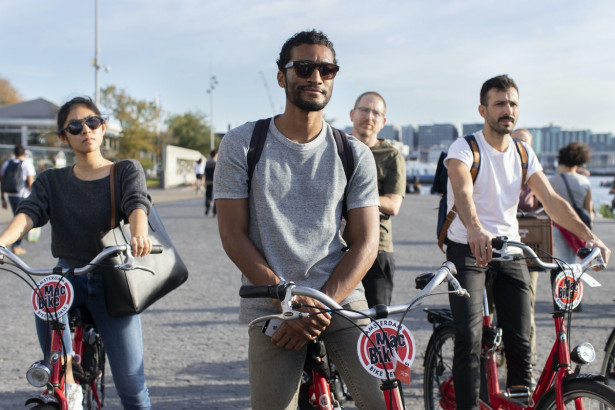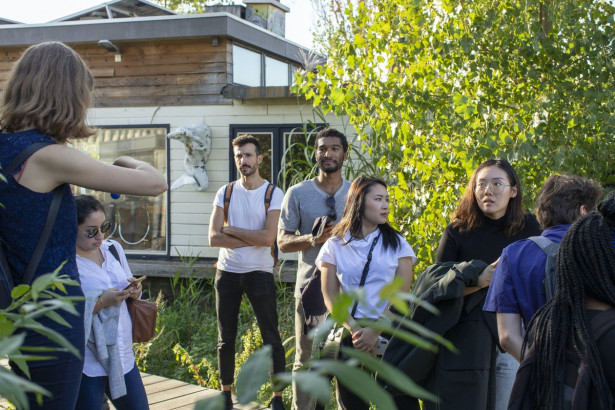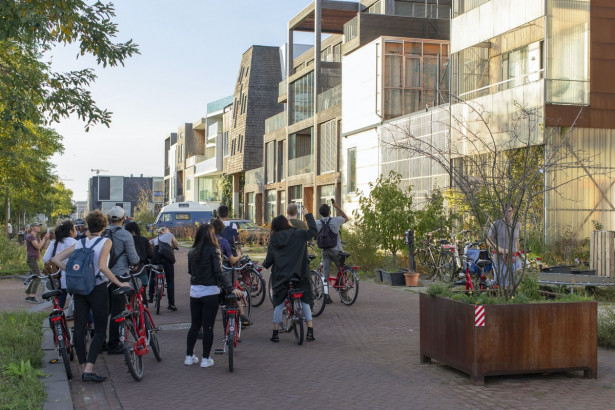From Ivy League to Living Lab — Harvard University Students Explore Circularity in Amsterdam North

Harvard University says its Architecture department is “a unique community, rich in diversity, and collaboration… where students explore today’s most creative design approaches.” This could not have been more true when its Master’s in Architecture students visited De Ceuvel — the epitome of uniqueness, diversity, and collaboration (without the quintessential ivy covered buildings).
Harvard University says its Architecture department is “a unique community, rich in diversity, and collaboration… where students explore today’s most creative design approaches.” This could not have been more true when its Master’s in Architecture students visited De Ceuvel — the epitome of uniqueness, diversity, and collaboration (without the quintessential ivy covered buildings).
On October 13th, Amsterdam Smart City hosted the delegation of Harvard University students who started their day by hearing about the open collective’s ecosystem from Cornelia Dinca, Amsterdam Smart City Delegations Lead and Founder of Sustainable Amsterdam. Cornelia also explained Amsterdam’s structural or strategic vision for being an “Economically Strong & Sustainable” city and how effective collaboration between the “quadruple helix” of residents, government, companies, and knowledge institutions is the key to the combined success of the economy and sustainability.
 Students then participated in an expert session led by Sladjana Mijatovic who presented Circular Innovation — Linking Knowledge, Innovation, Business, and People. Sladjana’s experience as Circular Innovation Officer for the City of Amsterdam enabled her to dive deep into the many facets of the City’s multitude of projects and initiatives supporting circularity. The students were most engaged around the discussion of moving from a linear to circular economy as it pertains to the large trend of increased urbanism, and the challenges that come from redeveloping historic areas while keeping sustainability at the forefront of the planning process.
Students then participated in an expert session led by Sladjana Mijatovic who presented Circular Innovation — Linking Knowledge, Innovation, Business, and People. Sladjana’s experience as Circular Innovation Officer for the City of Amsterdam enabled her to dive deep into the many facets of the City’s multitude of projects and initiatives supporting circularity. The students were most engaged around the discussion of moving from a linear to circular economy as it pertains to the large trend of increased urbanism, and the challenges that come from redeveloping historic areas while keeping sustainability at the forefront of the planning process.
 It’s one thing to hear about successful innovative circular development, however, experiencing it is another thing entirely. With this in mind, Cornelia led the group on a cycling tour through Amsterdam North – a fertile ground for creative and circular innovations.
It’s one thing to hear about successful innovative circular development, however, experiencing it is another thing entirely. With this in mind, Cornelia led the group on a cycling tour through Amsterdam North – a fertile ground for creative and circular innovations.
Students wandered through the boardwalk of De Ceuvel which was constructed on the polluted soil of a former shipyard. Through a unique collaboration between architecture firm Space & Matter and sustainability consultancy Metabolic, the former industrial space was transformed into an innovative community of artists and entrepreneurs. Four years on and De Ceuvel continues to lead the way as Amsterdam’s flagship “living lab,” having launched the “Joulitte” blockchain-based energy sharing token, and a biogas boat that converts De Ceuvel’s Café organic waste into biogas and fertilizer.

From De Ceuvel, the group continued on to the Buiksloterham neighborhood to view examples of cutting-edge sustainable and circular architecture. The students were inspired by “Palais Recup” developed by the owner salvaging all sorts of materials first, and then enlisting the services of an architect to design a home from what was available — a true example of innovation, experimentation, and creativity.
The group finished off the tour at NDSM-wharf, inside a shipbuilding hangar from 1919 which has now been transformed to “Kunststad” or “Art City”. Here artists had an opportunity to build a studio of their choice, co-creating what is said to be Europe’s largest breading ground for creatives.
They say an Ivy League education can open many doors. The most important of those being the one that leads you outside to “Challenge the status quo and change things around. From waste and pollution, to up cycling and recovery.”— As stated at the entrance to De Ceuvel.
Text by Beth St. John, Social Entrepreneur, Writer, and Founder of Aspire Institute. Photos by Thomas Schlijper.

